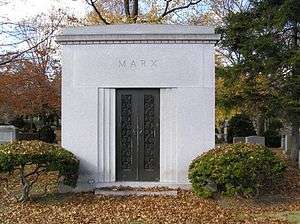Louis Marx
| Louis Marx | |
|---|---|
| Born |
August 11, 1896 Brooklyn, New York |
| Died |
February 5, 1982 (aged 85) White Plains, New York |
| Resting place | Woodlawn Cemetery, Bronx |
| Years active | 1919–1972 |
| Spouse(s) |
René (?-1944; her death) Idella Ruth Blackadder |
Louis Marx (August 11, 1896 – February 5, 1982) was an American toy maker and businessman whose company, Louis Marx and Company, was the largest toy company in the world in the 1950s. Described by many as an experienced businessman with the mind of child; Louis Marx’s ability to see into the minds of children around the world guided his toy creations and advertising efforts.[1]
Marx was known by numerous nicknames, including "Toycoon," "the Henry Ford of the toy industry," "the hawk of the toy industry," and "the toy king of America."
Biography
Born in Brooklyn, New York, to Austrian Jewish parents, Marx graduated from high school at age 15 and started his career working for Ferdinand Strauss, a manufacturer of mechanical toys. By 1916, Marx was managing Strauss' plant in East Rutherford, New Jersey. But within a year, Marx was fired by Strauss' board of directors over a disagreement about sales practices.
Marx then entered the United States Army as a private and attained the rank of sergeant before returning to civilian life in 1918. Marx's passion for the Army was reflected throughout his life; most of Marx's military toys represented Army equipment, and Marx would later make a practice of befriending generals and naming his sons after them.
Following military service, Marx then went to work selling for a Vermont-based manufacturer of wood toys, redesigned the product line, and increased the company's sales tenfold.[2]
In 1919 Marx and his brother David incorporated, founding the company that bore his name. Initially working as a middle man, Marx was soon able to purchase tooling to manufacture toys himself. When Strauss fell on hard financial times, Marx was able to buy the dies for two Strauss toys and turn them into best-sellers. By age 26, three years after founding his company, Marx was a millionaire.
By utilizing techniques of mass production and reusing old designs as much as possible – Marx utilized some of his toy train tooling developed in the early 1930s until 1972 – Marx was able to sell a broad line of inexpensive toys. All US-made toy trains would come from a plant in Girard, Pennsylvania, which produced millions of lithographed tin, and plastic toy trains.[3]
By 1951, the Marx company had 12 factories worldwide, and for much of the 1950s it was the largest toy manufacturer in the world, with much of the success coming from Sears, Roebuck & Co. catalog sales and the many themed playsets available. As World War II drew to a close, Marx had toured Europe and acted as a consultant on how toy manufacturing could aid reconstruction efforts. Marx used the contacts he made in this manner to forge partnerships and open factories in Europe and Japan. Marx was featured on the cover of Time magazine on December 12, 1955, with his portrait eclipsing an image of Santa Claus, while examples of his toys swirl in the background.
Marx's married his first wife, René Aber, in the 1920s when she was in the Follies. Rene's sister, Clara Aber and her mother moved into the Marx home, after their brother left Fort Crockette, Galveston, TX where he was first assigned after graduating from West Point. Rene died in 1944 of breast cancer at age 37. His second wife, Idella Ruth Blackadder (b. 1924), was nearly 28 years his junior.

Marx's daughter, Patricia, was born in 1938. She went on to become an activist author, and the second wife of Daniel Ellsberg, assisting him in the release of the Pentagon Papers. Louis Marx, a strident anti-Communist and supporter of Richard Nixon, regarded Ellsberg as a traitor afterwards.[4] Eldest child, Barbara Marx Hubbard (1929–), is a New Age futurist who is involved in helping humans make an evolutionary shift to a higher and better consciousness.
Marx's son, Louis Marx Junior, is a venture capitalist, and a philanthropist who has contributed to the arts, education and medicine. One such example is the Louis Marx Center for Children and Families of New York.
The industrialist retired in 1972, selling his company to Quaker Oats for $54 million. Marx was 76 years old and his company had been declining. The drop off has been blamed variously on the company's slowness to develop electronic toys and on Marx's unwillingness to employ salesmen for fear of someone else repeating his early experience with Strauss.
Louis Marx died at the hospital in White Plains, New York, at age 85. He is interred in a private mausoleum in Woodlawn Cemetery, Bronx, New York.


Notes
- ↑ "Information Marx History". marxtoymuseum.com. Retrieved 2015-12-04.
- ↑ Time Magazine article 1955
- ↑ "Introduction Guide to MarX Trains & Toys -The Toy King Louis Marx". eBay.
- ↑ Wells, Tom (2001). Wild Man: The Life and Times of Daniel Ellsberg. Palgrave. ISBN 0-312-17719-4
References
- Matzke, Eric (1985) Greenberg's Guide to Marx Trains, 2nd Edition. Greenberg Publishing Company, 1985. ISBN 0-89778-026-4.
- Wells, Tom (2001). Wild Man: The Life and Times of Daniel Ellsberg. Palgrave. ISBN 0-312-17719-4.
- Schievelbein, D (2007) "MarX Trains and Toys Guide : The Toy King Louis Marx". eBay Guide